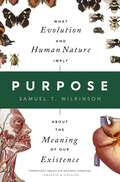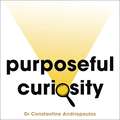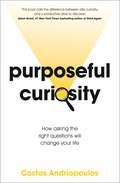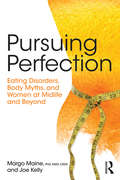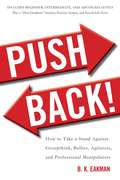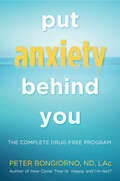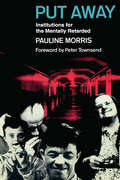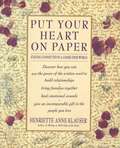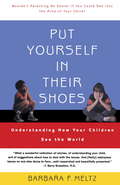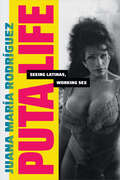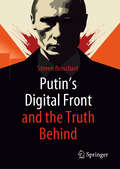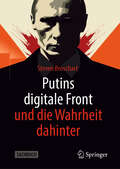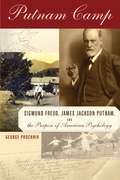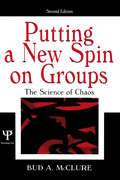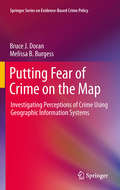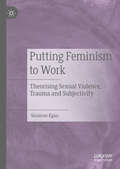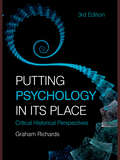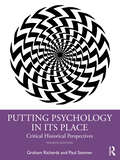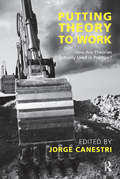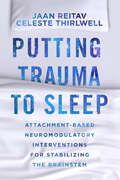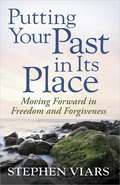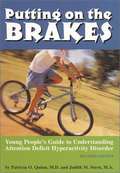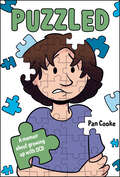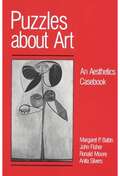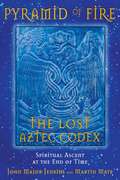- Table View
- List View
Purpose: What Evolution and Human Nature Imply about the Meaning of Our Existence
by Samuel T. WilkinsonBy using principles from a variety of scientific disciplines, Yale Professor Samuel Wilkinson provides a framework for human evolution that reveals an overarching purpose to our existence. Generations have been taught that evolution implies there is no overarching purpose to our existence, that life has no fundamental meaning. We are merely the accumulation of tens of thousands of intricate molecular accidents. Some scientists take this logic one step further, suggesting that evolution is intrinsically atheistic and goes against the concept of God. But is this true? By integrating emerging principles from a variety of scientific disciplines—ranging from evolutionary biology to psychology—Yale Professor Samuel Wilkinson provides a framework of evolution that implies not only that there is an overarching purpose to our existence, but what this purpose is. With respect to our evolution, nature seems to have endowed us with competing dispositions, what Wilkinson calls the dual potential of human nature. We are pulled in different directions: selfishness and altruism, aggression and cooperation, lust and love. When we couple this with the observation that we possess a measure of free will, all this strongly implies there is a universal purpose to our existence. This purpose, at least one of them, is to choose between the good and evil impulses that nature has created within us. Our life is a test. This is a truth, as old as history it seems, that has been espoused by so many of the world&’s religions. From a certain framework, these aspects of human nature—including how evolution shaped us—are evidence for the existence of a God, not against it. Closely related to this is meaning. What is the meaning of life? Based on the scientific data, it would seem that one such meaning is to develop deep and abiding relationships. At least that is what most people report are the most meaningful aspects of their lives. This is a function of our evolution. It is how we were created.
Purposeful Curiosity: How asking the right questions will change your life
by Dr Dr Costas AndriopoulosOpen your mind to radical curiosity and be inspired by the journeys of curious and inquisitive people in order to push boundaries, make new discoveries and find meaning and purpose in your own life.This audiobook offers a masterclass in the power of purposeful curiosity to succeed and lead a fulfilled life. Dr Costas Andriopoulos has spent the last five years interviewing the most curious minds working today, focused on people who have harnessed their inquisitive minds and innovative thinking to achieve great things across a variety of fields. In this audiobook he explores the way these special people have channelled and fed their curiosity with purpose and weaves in gripping insights and advice from the interviews along with cutting-edge research from psychology, neuroscience, management, history, sociology and anthropology to illuminate the purposefully curious approach. Packed with practical tools alongside the fascinating narrative, the audiobook offers Dr Andriopoulos' nine essential lessons that will allow you to make use of curiosity in your own life to empower you - whatever your journey - and help you replicate the experiences of others to reach your goals and thrive.(P) 2022 Hodder & Stoughton Limited
Purposeful Curiosity: How asking the right questions will change your life
by Dr Dr Costas AndriopoulosThis book offers a masterclass in the power of purposeful curiosity to succeed and lead a fulfilled life. Dr Costas Andriopoulos has spent the last five years interviewing the most curious minds working today, focused on people who have harnessed their inquisitive minds and innovative thinking to achieve great things across a variety of fields. In this book he explores the way these special people have channelled and fed their curiosity with purpose and weaves in gripping insights and advice from the interviews along with cutting-edge research from psychology, neuroscience, management, history, sociology and anthropology to illuminate the purposefully curious approach. Packed with practical tools alongside the fascinating narrative, the book offers Dr Andriopoulos' nine essential lessons that will allow you to make use of curiosity in your own life to empower you - whatever your journey - and help you replicate the experiences of others to reach your goals and thrive.
Pursuing Perfection: Eating Disorders, Body Myths, and Women at Midlife and Beyond
by Joe Kelly Margo MaineIn Pursuing Perfection, authors Margo Maine and Joe Kelly explore the emotional, social and cultural factors behind the ongoing epidemic of disordered eating and body image despair in adult women at midlife and beyond. Written from a biopsychosocial and feminist perspective, Pursuing Perfection describes the many issues women encounter as they navigate a rapidly changing culture that promotes unhealthy standards for beauty and appearance. This updated and expanded edition (originally published as The Body Myth: Adult Women and the Pressure to Be Perfect) is a unique guide for anyone seeking practical tools and strategies for adult women looking to establish health and body acceptance.
Push Back!: How to Take a Stand Against Groupthink, Bullies, Agitators, and Professional Manipulators
by B. K. EakmanHow many times have you had the unsettling experience of being treated as a troublemaker as soon as you question or raise an objection to a school policy, a textbook, a course of study, a new county regulation, or a community proposal?Every day, attendees of conferences, community forums, PTA meetings, and board meetings are made to feel uncomfortable and occasionally foolish by the person or persons leading the meeting. The speakers, moderators, or provocateurs-whom author B. K. Eakman refers to as professional manipulators-hold power over the room and know how to steer the discussion back to their agendas without ever answering audience questions or addressing their concerns. These people use techniques to ostracize those brave enough to stand and question or criticize them.With Push Back!, readers will be able to counter group manipulation tactics by learning to:Recognize psychologically controlled environmentsIdentify the professional agitator/provocateurExamine components of psych warUndercut faulty, distorted, and biased arguments of opponentsSquelch techniques used to rebuff audience members who complain or balkNeutralize consensus-building techniquesAnd much more
Put Anxiety Behind You: The Complete Drug-Free Program
by Peter BongiornoAn all-natural, practical program for anxiety relief from the naturopathic doctor and author of How Come They&’re Happy and I&’m Not. With twenty years of research on the subject and more than a decade of helping patients free themselves from the grip of anxiety, naturopathic physician Peter Bongiorno now shares the insights, information, and tools you need to beat anxiety naturally. Taking all aspects of the mind and body into consideration, Bongiorno looks for and addresses the underlying causes of different types of anxiety disorders, and helps readers consider and develop new anti-anxiety habits. If you're one of the forty million Americans trying to stop panic attacks or overcome social anxiety, learn how to safely wean yourself off of medication and consider naturopathy treatment. In addition to case studies and a handy instruction guide, you&’ll find information on: Food, vitamins, and herbs for anxietyAnxiety-reducing yoga poses and massage techniquesAcupressure points
Put Away: Institutions for the Mentally Retarded (International Library Of Sociology Ser.)
by Pauline MorrisThis classic book allows its readers for the first time to comprehend the size, organization, staffing and operation of a national system of hospitals and residential services for the subnormal. It also allows for the first time, reliable estimates to be given of the scale and severity of certain problems. The basis has been laid for an evaluation of the effectiveness of hospitals for the subnormal. All this has been made possible by a generous grant from the National Society for Mentally Handicapped Children to the Department of Sociology in the University of Essex upon the foundation of the University. Of course, a great deal of further research remains to be done but a preliminary network of information is now available to all those deeply concerned about the handicapped.This is a study of the range and quality of institutional provisions made in England and Wales for that group of handicapped individuals who are known as mentally deficient. Dr. Morris reports on an investigation, which covered nearly half the hospitals for the sub-normal in the country: many of its findings can only shock and dismay.The investigation was concerned to discover what facilities-physical, occupational and educational-there was for patients, and to learn more about their social environment. It was also concerned to determine the extent to which both staff and patients are affected by their social environment, and by administrative action, and to learn something of the relationship between the hospital as an institution and the outside community, as well as between the patients and the outside world. In addition, it examined the extent to which the provisions and facilities available met the needs of the patients in relation to their physical and mental handicaps.
Put Your Heart on Paper: Staying Connected In A Loose-Ends World
by Henriette Anne KlauserPut Your Heart On Paper is filled with the inspiring true stories of what happens when people write from their hearts: the shared insights, the new beginnings, the dreams that miraculously come true. In 50 provocative short chapters, acclaimed author Henriette Klauser shows the power of the written word in everyday life -- bringing together parents and children, strengthening personal bonds, mending hurt feelings, solving problems, sharing joys, preserving family history -- and offers tools and tips to get you started right away. Putting your heart on paper does not require special talent, a lot of time or training. All you need is a willingness to be yourself and to be open with others. Nauser's energizing examples show how to get going and keep going past the fear and doubt -- and offer dozens of ideas to try. From a note tucked in a lunchbox to an interactive journal, from love letters to apologies to a three-minute poem, Put Your Heart On Paper shows us how to find a direct line from our deepest thoughts to another's heart.(From the Trade Paperback edition.)
Put Yourself in Their Shoes
by Barbara MeltzWouldn't parenting be easier if you could see into the mind of your child?Learn to hear what your child can't or won't tell you--and Understand Behavior Build Values Nurture Closeness Solve ProblemsIn her popular Boston Globe column "Child Caring," Barbara Meltz has been writing about real-life parenting issues for more than a decade. She has found that instead of divorce or moving--the situations parents think of as stressful--children's concerns are often linked to commonplace events such as sleepovers or the first day of school.In this wise, compassionate book, Meltz offers parents a unique window into their child's inner life. She includes candid, illuminating observations from kids themselves and offers advice on what to ask, listen for, or observe to decode puzzling behavior. . . how to get a child to talk about his or her problems. . . and how to find the best way to solve conflicts. By focusing on developmental trouble spots, not age, her approach is as helpful to the parents of a two-year-old as to those of a twelve-year-old. From keeping secrets to going to camp to larger issues, such as stealing or death in the family, Put Yourself in Their Shoes offers a way to see inside a child's world--and help to make it safe and strong.From the Trade Paperback edition.
Puta Life: Seeing Latinas, Working Sex (Dissident Acts)
by Juana María RodríguezIn Puta Life, Juana María Rodríguez probes the ways that sexual labor and Latina sexuality become visual phenomena. Drawing on state archives, illustrated biographies, documentary films, photojournalistic essays, graphic novels, and digital spaces, she focuses on the figure of the puta—the whore, that phantasmatic figure of Latinized feminine excess. Rodríguez’s eclectic archive features the faces and stories of women whose lives have been mediated by sex work's stigmatization and criminalization—washerwomen and masked wrestlers, porn stars and sexiles. Rodríguez examines how visual tropes of racial and sexual deviance expose feminine subjects to misogyny and violence, attuning our gaze to how visual documentation shapes perceptions of sexual labor. Throughout this poignant and personal text, Rodríguez brings the language of affect and aesthetics to bear upon understandings of gender, age, race, sexuality, labor, disability, and migration. Highlighting the criminalization and stigmatization that surrounds sex work, she lingers on those traces of felt possibility that might inspire more ethical forms of relation and care.
Putin's Digital Front and the Truth Behind
by Steven BroschartPutin's war in Ukraine is not only fought on the battlefield. Combat also occurs on the digital front. Words and information are the ammunition of modern, hybrid warfare—against the opposing military, but especially against civilians. It is about manipulation and control. About confusion and distraction from what is really happening. However, the internet is used not only for propaganda but also for intelligence and logistics. In doing so, Russia leaves behind a lot of traces. Analyst Steven Broschart demonstrates in clear language that requires no prior knowledge which psychological and communicative means are employed at Putin's digital frontline.
Putins digitale Front und die Wahrheit dahinter
by Steven BroschartPutins Krieg in der Ukraine wird nicht nur auf dem Schlachtfeld ausgetragen. Gekämpft wird auch an der digitalen Front. Worte und Informationen sind die Munition der modernen, der hybriden Kriegsführung - gegen das gegnerische Militär, aber insbesondere gegen Zivilisten. Es geht um Manipulation und Kontrolle. Um Verwirrung und Ablenkung von dem, was wirklich geschieht. Doch das Internet wird nicht nur zur Propaganda, sondern auch für die Aufklärung und die Logistik genutzt. Und dabei hinterlässt Russland eine Menge Spuren. Analyst Steven Broschart zeigt konkret, welche psychologischen und kommunikativen Mittel an Putins digitaler Frontlinie zum Einsatz kommen.
Putnam Camp: Sigmund Freud, James Jackson Putnam and the Purpose of American Psychology
by George ProchnikWinner of the 2007 Gradiva AwardAn innovative work of biography that traces the lasting impact of the friendship between Sigmund Freud and pioneering American psychologist James Jackson Putnam. In 1909 Sigmund Freud made his only visit to America, which included a trip to "Putnam Camp"-the eminent American psychologist James Jackson Putnam's family retreat in the Adirondacks. "Of all the things that I have experienced in America, this is by far the most amazing," Freud wrote of Putnam Camp. Putnam, a Boston Unitarian, and Freud, a Viennese Jew, came from opposite worlds, cherished polarized ambitions, and promoted seemingly irreconcilable visions of human nature-and yet they struck up an unusually fruitful collaboration. Putnam's unimpeachable reputation played a crucial role in legitimizing the psychoanalytic movement. By the time of Putnam's death in 1918, psychoanalysis had been launched in America, where-in large part thanks to the influence of Putnam, and in a development Freud had not anticipated-it went on to become a practice that moved beyond the vicissitudes of desire to cultivate the growth and spiritual aspirations of the individual as a whole. Putnam Camp reveals details of Putnam's and Freud's personal lives that have never been fully explored before, including the crucial role Putnam's muse, Susan Blow-founder of America's first kindergarten, pioneering educator and philosopher in the American Hegelian movement-played in the intense debate between these two great thinkers. As the great-grandson of Putnam, author George Prochnik had access to a wealth of personal firsthand material from the Putnam family-as well as from the James and Emerson families-all of which contribute to a new and intimate vision of the texture of daily life at a moment when America was undergoing a cultural and intellectual renaissance.
Putting A New Spin on Groups: The Science of Chaos
by Bud A. McclurePutting a New Spin on Groups: The Science of Chaos, Second Edition continues to challenge orthodoxy and static ideas about small group dynamics. A primary goal is to offer an alternative model of group development that addresses three factors: *The model integrates old ideas from previous models of group development with new concepts from chaos theory and the work of Arthur Young. *The book emphasizes the importance of conflict in group development and recognizes that group growth--while progressive--is neither linear or unidimensional. *Particular attention is focused on how groups change, evolve, and mature. In addition, this book highlights certain group phenomena that have been given only cursory attention in many group textbooks, including women in authority, group metaphors, regressive groups, and the transpersonal potential of small groups. This book has been revised in response to feedback from reviewers and colleagues and includes new ideas, applications of chaos theory in social sciences, and thinking about group behavior. It is an intellectually challenging read with just the right amount of world application.
Putting Fear of Crime on the Map
by Melissa B. Burgess Bruce J. DoranSince first emerging as an issue of concern in the late 1960s, fear of crime has become one of the most researched topics in contemporary criminology and receives considerable attention in a range of other disciplines including social ecology, social psychology and geography. Researchers looking the subject have consistently uncovered alarming characteristics, primarily relating to the behavioural responses that people adopt in relation to their fear of crime. This book reports on research conducted over the past eight years, in which efforts have been made to pioneer the combination of techniques from behavioural geography with Geographic Information Systems (GIS) in order to map the fear of crime. The first part of the book outlines the history of research into fear of crime, with an emphasis on the many approaches that have been used to investigate the problem and the need for a spatially-explicit approach. The second part provides a technical break down of the GIS-based techniques used to map fear of crime and summarises key findings from two separate study sites. The authors describe collective avoidance behaviour in relation to disorder decline models such as the Broken Windows Thesis, the potential to integrate fear mapping with police-community partnerships and emerging avenues for further research. Issues discussed include fear of crime in relation to housing prices and disorder, the use of fear mapping as a means with which to monitor the impact of Closed Circuit Television (CCTV) and fear mapping in transit environments.
Putting Feminism to Work: Theorising Sexual Violence, Trauma and Subjectivity
by Suzanne EganThis book explores the place of feminism and uptake of trauma in contemporary work against sexual violence. Egan presents a refreshing alternative position on arguments about the co-optation or erasure of feminism within institutionalized, professionalized services for sexual assault victims. Using original research on Australian sexual assault services, Putting Feminism to Work effectively illustrates how feminist concepts and ideas have become routinized in contemporary services and enacted in daily practices with survivors and communities. The book engages with, yet resists, the notion that feminist engagement with knowledge (trauma) based in psychiatry and clinical psychology is incompatible with feminism or inevitably reduces sexual violence to a problem of individual healing. Indeed Egan argues that the productive ways practitioners integrate neurobiological understandings of trauma into their work suggests rich possibilities for reintroducing a non-essentialist biology of the body into feminist theories of sexual violence. Scholars, students and practitioners working in the fields of violence against women, sociology, women’s and gender studies, health, social work and policy studies, as well as the emerging field of sociologically informed trauma studies, will find this book of interest.
Putting Psychology in its Place, 3rd Edition: Critical Historical Perspectives
by Graham RichardsThe third edition of Putting Psychology In Its Place builds on the previous two editions, introducing the history of Psychology and placing the discipline within a historical context. It aims both to answer and raise questions about the role of Psychology in modern society, by critically examining issues such as how Psychology developed, why psychoanalysis had such an impact and how the discipline has changed to deal with contemporary social issues such as religion, race and gender. This new third edition contains two completely new chapters: "Emotion: The Problem or the Whole Point?" and "Funding and Institutional Factors." An expanded epilogue has also been added which incorporates a discussion of the conceptual issues raised in the book and the volume now corresponds with the new BPS requirements for undergraduate courses. Other chapters, including those on Psychology and the Brain, Social Psychology and the Psychology of Madness, as well as those on gender, religion and race, have been substantially revised. Putting Psychology In Its Place is imaginatively written and accessible to all. It is an invaluable introductory text for undergraduate students of the history of Psychology and will also appeal to postgraduates, academics and anyone interested in Psychology or the history of science.
Putting Psychology in its Place: Critical Historical Perspectives
by Graham Richards Paul StennerThis fourth edition of Putting Psychology in Its Place builds on the previous three in introducing the history of Psychology and placing the discipline within its historical and social contexts. Written by esteemed Psychologists Graham Richards and Paul Stenner, this crucial text aims both to answer and raise questions about the role of Psychology in modern society by critically examining issues such as how Psychology developed and why psychoanalysis had such an impact. It discusses enduring underlying conceptual problems and examines how the discipline has changed to deal with contemporary social issues such as religion, race and gender. The fourth edition features revised and updated chapters, though the core structure remains unchanged. The final chapter has been restructured and jointly re-written. This text was written to remain compatible with the British Psychological Society requirements for undergraduate courses and is imaginatively written and accessible to all. Putting Psychology in Its Place is an invaluable introductory text for undergraduate students of the history of Psychology and will also appeal to postgraduates, academics and anyone interested in Psychology or the history of science.
Putting Theory to Work: How are Theories Actually Used in Practice? (The Developments in Psychoanalysis Series)
by Jorge CanestriThis book contains a continuation and expansion of the topics covered in the author's previous book, Psychoanalysis: from Practice to Theory, about the use of theories in analytic practice. As a member of the International Psychoanalytical Association (IPA) Conceptual Research Committee and Chair of the Working Party on Theoretical Issues, the author, who teaches at Nanterre University, has studied and taught on the subject for several years, as well as writing many articles on it. The book will be particularly useful for psychoanalytical and psychotherapeutic societies, as well as for research committees.
Putting Trauma to Sleep: Attachment-Based Neuromodulatory Interventions for Stabilizing the Brainstem
by Jaan Reitav Celeste ThirlwellSleep disturbances and trauma are intrinsically linked—so why aren’t therapists trained in sleep repair? Anyone who has suffered from trauma knows what it means to have sleepless nights. In fact, research has shown that at the heart of both trauma and sleep disorders is a dysregulated brainstem with heightened sympathetic nervous system activity. Yet, current trauma treatments largely ignore this profound interconnection between trauma and sleep. Putting Trauma to Sleep proposes that incorporating a therapeutic TABS model (traumatic events, attachment disturbances, bodily symptoms, sleep repair), therapists can better aid their clients in both healing from trauma and restoring sleep. With practical clinical approaches and illustrative case examples, sleep specialists Jaan Reitav and Celeste Thirlwell demonstrate how therapists and their clients can integrate sleep repair into trauma work by enhancing parasympathetic nervous system tone and actively attending to shock reactions in the body. Dysfunctional sleeping patterns have been ignored for too long within the psychotherapy sphere; this indispensable resource will transform readers’ understanding of both sleep and trauma therapy.
Putting Your Past in Its Place: Moving Forward in Freedom and Forgiveness
by Stephen ViarsLives grind to a halt when people don’t know how to relate to their past. Some believe “the past is nothing” and attempt to suppress the brokenness again and again. Others miss out on renewal and change by making the past more important than their present and future. Neither approach moves people toward healing or hope. Pastor and biblical counselor Stephen Viars introduces a third way to view one’s personal history—by exploring the role of the past as God intended. Using Scripture to lead readers forward, Viars provides practical measures to understand the important place “the past” is given in Scripture replace guilt and despair with forgiveness and hope turn failures into stepping stones for growth This motivating, compassionate resource is for anyone ready to review and release the past so that God can transform their behaviors, relationships, and their ability to hope in a future.
Putting on the Brakes (Revised Edition): Young People's Guide to Understanding Attention Deficit Hyperactivity Disorder
by Patricia O. Quinn Judith M. SternExplains what attention deficit disorder is and how to treat it, discussing the cognitive and emotional aspects, what the medication options are, how to maintain positive relations with friends, and how to do well at school.
Puzzled: A Memoir about Growing Up with OCD
by Pan CookeGrowing up with undiagnosed OCD sure isn&’t easy, and here Pan Cooke shares his own experiences with that condition in a graphic-novel memoir that is as funny as it is powerfully candid and openhearted.Pan Cooke is ten years old when anxious thoughts begin to take over his brain like pieces of an impossible puzzle. What if he blurts out a swear word while in church? What if he accidentally writes something mean in his classmate&’s get-well card? What if his friend&’s racy photo of a supermodel ends up in his own homework and is discovered by his teacher? More and more, he becomes hijacked by fears that can only be calmed through exhausting, time-consuming rituals.Pan has no way of knowing that this anxiety puzzle and the stressful attempts to solve it are evidence of a condition called Obsessive Compulsive Disorder. This is his story of living with and eventually learning about OCD. Told with endearing honesty and humor, Puzzled shows the reader the importance of empathy for oneself and those going through something they don&’t yet understand.
Puzzles About Art: An Aesthetics Casebook
by John Fisher Anita Silvers Margaret Pabst Battin Ronald MooreThe first casebook for use in courses in aesthetics, Puzzles about Art provides more than 180 real and hypothetical cases that illustrate important principles and theories in the philosophy of art. With 25 illustrations as well as concrete examples from legal cases, museum experiences, newspaper articles and various media, including painting, sculpture, photography, music, drama, and film, Puzzles about Art helps students understand specific problems in the visual arts.
Pyramid of Fire: Spiritual Ascent at the End of Time
by John Major Jenkins Martin MatzThe first translation of a previously unknown Aztec codex and its initiatory teachings for 2012• Discloses the potential for great spiritual awakening offered at the end of the Aztec calendar cycle• Presents the only existing English-language transcription of the Aztec codex, with line-by-line commentary• Contains the epic poetry and metaphysical insights of Beat poet Marty Matz (1934–2001In 1961 an unknown Aztec codex was revealed to Beat poet and explorer Marty Matz by a Mazatec shaman in the mountains of Oaxaca, Mexico. Originally intended for dramatic performance, this codex presents a profound metaphysical teaching describing how the end of time will bring about a visionary ascent. At the behest of his Mazatec teacher, Matz transcribed this pictorial codex into a literary form that would preserve its initiatory teachings and reveal its secret meanings to a wider audience.Pyramid of Fire is an epic poem that provides a vehicle to transport the initiate into the higher realms of consciousness. It represents a barely surviving thread of teachings that have been passed down in secret since the time of the Spanish Conquest. Revealed are the techniques by which man is transported to the stellar realm after death via the solar energy within what the ancients called the “serpent of consciousness.” Line-by-line commentary by Matz and John Major Jenkins provides insights into the perennial philosophy contained in the codex and its relevance to our times.
